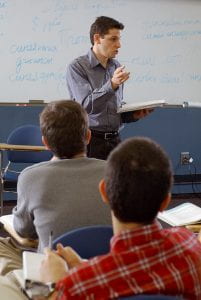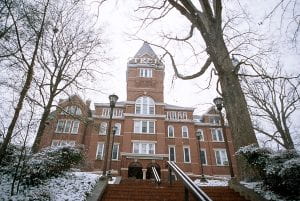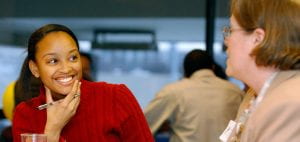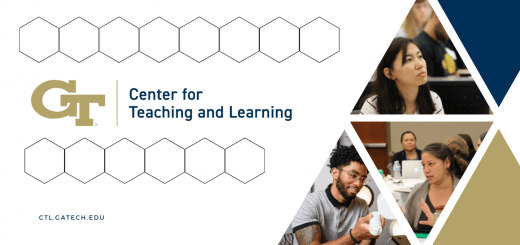How Do You Begin an Academic Career Search?
 There are many factors to consider when deciding what type of job would be an appropriate fit for you. Below are some questions you will want to answer to identify what considerations are most important in your search for a position in academia.
There are many factors to consider when deciding what type of job would be an appropriate fit for you. Below are some questions you will want to answer to identify what considerations are most important in your search for a position in academia.
What types of positions are you considering?

Stuart Goldberg teaches class.
- Tenure-track faculty, after a period, undergo a review process that can grant tenure, or permanent employment, at an institution. Research and teaching responsibilities depend on the institution.
- Teaching/adjunct faculty primarily have teaching responsibilities, conduct little to no research, and are not subject to a review for tenure. Non-tenured teaching positions are not permanent, and the salary is often based on the number of courses taught.
- Research faculty primarily conduct research, have little to no teaching responsibilities, and are not subject to a review for tenure.
- Administrative/academic professional positions vary greatly and can include, but are not limited to, academic program coordinators, grant administrators, education development staff, and other campus resource staff.
- Postdoctoral fellowships typically last half a year to several years and allow recent graduates to continue building their curricula vitae with additional research and teaching experience before applying to tenure-track positions.
If you are in a STEM discipline, you can create an individual development plan by completing an inventory of your scientific and mathematical skills, interests, and values to see which of 20 different STEM career paths would be more suitable for you.

Tech Tower with snow. Georgia Tech is classified as an R1 institution due to its high research productivity.
What types of institutions are you considering?
The Carnegie Classification of Institutions of Higher Education categorizes accredited colleges and universities in the U.S. according to degree programs and research productivity. This classification can give you a general idea of how much focus there is on research versus teaching for a faculty position. Educational institutions are designated as:
- Doctoral universities, which are further classified as:
- R1 – highest research activity
- R2 – higher research activity
- R3 – moderate research activity
- Master’s colleges and universities
- Baccalaureate colleges
- Baccalaureate/associate’s colleges
- Associate’s colleges
- Special focus schools
- Tribal colleges
How well do you meet the qualifications for the types of positions and institutions you are considering?

David Collard and Shannon Watt. Mentorship of students can still be an important responsibility for some research-intensive positions.
The Academic Career Readiness Assessment (ACRA) provides aggregated information about what search committees typically seek from applicants for different types of academic positions. You can use this information to determine how well you meet the expectations for a position or what you can do to better meet these expectations.
- Research-intensive positions heavily emphasize publications, research independence and fundability, scientific vision, and recommendations supporting quality of work, with some consideration for your ability to communicate your research.
- Research and teaching positions value publications and research feasibility, but teaching experience and competency, as well as the ability to mentor other students conducting research, are considered equally important. These positions also tend to consider the potential for working well with colleagues.
- Teaching-only positions stress teaching philosophy and experiences and a commitment to working with diverse students.
How do you find job openings?
Take advantage of as many different strategies as you can to broaden your search for potential positions.
- Personal and professional networks
- Employment pages on individual institution websites
- Discipline-specific job postings
- conferences
- professional organizations
- journals
- Academic job postings
- academic job search engines: Higher Ed Jobs, University Jobs, Academic Careers Online
- professional publications: Chronicle of Higher Education, Inside Higher Ed
- academic career-resource websites: Higher Education Recruitment Consortium, HigherEd360
- General job postings
- job search engines: Indeed, CareerBuilder, ZipRecruiter, SimplyHired, Glassdoor
- social media: LinkedIn, Facebook, Twitter
What are typical job search timelines?
Many job postings following academic calendars, with positions starting at the beginning of an academic year. Some disciplines have very specific job markets with a highly formalized and structured application process. The specifics of the timelines depend on your field, but regardless of discipline, the entire process generally takes about a year. Using a typical academic-year schedule, a sample timeline would be:

Practicing for interviews can help job seekers be better prepared and feel more confident.
Summer – prepare curriculum vitae and other application materials, consider who your references will be
Fall – search job postings, research schools, solicit letters of recommendation, submit applications
Winter – prepare job talks, practice interviews
Spring – visit campuses, decline/accept and negotiate job offers
What application materials will you need to prepare?
At minimum, you will need a cover letter that is tailored to each specific job opening and a curriculum vitae. The other materials that will be a part of your application packet will depend on the type of institution and the nature of the position. These supplemental materials can include, but are not limited to: a research statement, teaching statement, diversity statement, and references. Additional workshops and resources about these materials are available through CTL.
Are there any other considerations to keep in mind?
- Salary and/or lab budgets
- Job trends for your discipline and the labor force at large
- Institutional characteristics, such as size or diversity and demographics of students, faculty, and staff
- Geographic location, cost of living, and amenities
- For international applicants, visa and work authorization requirements. Please visit Georgia Tech’s Office of International Education to learn more.
Final Tips
- Demonstrate your professionalism and attention to detail with carefully crafted application materials.
- Apply early to ensure that you do not miss opportunities with rolling deadlines.
- Apply to many positions to maximize your chances of finding a job.
- Be realistic about your timeline, the job market, and the types of jobs that might be suitable.
Additional Resources
Schedule a consultation with CTL staff for more personalized guidance and assistance.





